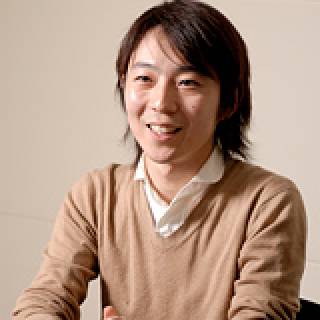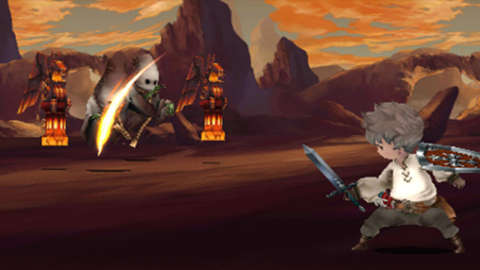Bravely Default (originally titled Bravely Default: Flying Fairy) came out in Japan in 2012, and Europe in 2013. Now, a year and a half after its debut, it's finally available to 3DS owners in North America. During that time, the game underwent a litany of changes, earning a rerelease in Japan under a new subtitle, Bravely Default: For the Sequel. As the name implies, Silicon Studio, the team behind Bravely Default, is already working on the successor: Bravely Second. Interestingly enough, according to producer Tomoya Asano, Bravely Default was originally envisioned as a sequel to a preexisting game from another series: Final Fantasy: The 4 Heroes of Light.
Asano said, "As it turns out, we originally, in the early planning stages, were looking at this project as a sequel to Final Fantasy: The 4 Heroes of Light, and we had spoken to Silicon Studio who had created a demo for that project, and we liked what we saw and decided to work with them."
Though Bravely Default eventually moved away from the Final Fantasy brand, it retains several ties to the series, causing many players to refer to it as the best Final Fantasy game in years.

"There are certainly some elements, like the turn-based battles or the job system or traveling around the world looking for crystals, that will feel like familiar elements to fans of the classic Final Fantasy series, but the reason that they exist in this game is that we know that these are elements that are going to make for ease of play and a comfortable play experience.
"I think that it's possible that some of the similarity of item names are due to the fact that we originally conceived of this as a sequel to Final Fantasy: The 4 Heroes of Light; it might be just an artifact of that process. But there's also some deliberate thinking about it as well in that we know that people that were fans of the Final Fantasy series, and there certainly were a lot of them, enjoy seeing similar elements, and we know that it's fun for them."
Does that mean the game was designed to mimic classic Final Fantasy games, first and foremost? It may seem that way at first but once you dig into the combat and town-building system, you immediately realize there's more to Bravely Default than things lifted from Final Fantasy's playbook, and it begins to form an identity of its own. Asano points out that "we have also incorporated lots of interesting new elements that have not been seen in games in that series up till now."
There's a good chance he's referring to the game's combat system, which lets you borrow or bank turns during battle, but it's not the only deviation from the norm that may surprise players. Bravely Default incorporates numerous social features that allow you to augment various parts of the game. Once you start streetpassing with other Bravely Default players, you'll be able to summon friends into battle, borrow abilities from high-level characters, and gather a crew to open, repair, and upgrade item shops.
"One of our basic concepts for Bravely Default was that it would be a single-player RPG that you could enjoy and play with everyone, and what I mean by that is that you're able to get help from your friends in a lot of different ways. In this case, we're talking about the StreetPass functionality for friend summoning in particular, and this is something that we had to do a lot of balance checking around. But we were able to come up with a solution that we feel is really good for new players and allows for advanced play...and we think that we're going to see some interesting emerging gameplay around this once the game is out for a little while. That will hopefully spur us on to new ways to help these new players, and one thing that we've already been talking about is the ability to update [characters] on the Internet, for example."
Minecraft – Kung Fu Panda DLC Trailer Sclash - Console Release Date Trailer Kingdom Come: Deliverance 2 - Official Cinematic Announcement Trailer Stellar Blade - BIBI ‘Eve’ Official Music Video Trailer | PS5 Apex Legends: Urban Assault Collection Event Trailer Total War: WARHAMMER III - Elspeth von Draken Gameplay Showcase Potionomics: Masterwork Edition - Official Announcement Trailer Genshin Impact - "Arlecchino: Sleep in Peace" | Official Character Teaser Snowbreak: Containment Zone - "Gradient of Souls" Version Trailer Harold Halibut GameSpot Video Review Nancy Drew: Mystery of the Seven Keys | World Premiere Official Trailer Modern Warfare III & Warzone - Official Cheech & Chong Bundle Gameplay Trailer
Please enter your date of birth to view this video
By clicking 'enter', you agree to GameSpot's
Terms of Use and Privacy Policy
Nintendo published Bravely Default in Europe and North America, but Asano and Silicon Studio were committed to developing the game for the 3DS before Nintendo ever got involved.
"As it turns out, one of our very deliberate mottos when working on this game was the phrase 'only on 3DS.' So, we had a lot of ideas about how to use every single feature of the 3DS and incorporate it into gameplay here, and you'll certainly see that with the StreetPass features and the augmented-reality cards. But there's definitely an element of the visual presentation that works especially well on the 3DS also, and we knew this from a very early stage when we were looking at things as simple as illustrations and maps and thinking about how we wanted to represent space within the game."
Asano points out a feature that may slip past most players at first, which is too bad, because it actually makes a big difference in practice.
"One other thing that I think represents a really good point of compatibility with the Nintendo 3DS is the way that we have designed the game so that you can play it only with your left hand, if you so choose, using the direction pad."

The functions of the four inputs on the right side of the 3DS translate perfectly to the four inputs on the D-pad, while the analog stick is used for movement. Thus, you can accomplish everything with a single hand. It's a simple feature, but one that grows on you over time.
It's also a feature that was introduced as part of the upgrade to the For the Sequel version of Bravely Default, which was designed around feedback from fans provided directly to Asano and Silicon Studio. They didn't just read forums and reviews. Rather, Asano and company reached out directly to fans. With the approval for a sequel secured, they wanted to make the best Bravely Default possible.
"Well, we were very fortunate that the first title was so well received in Japan. It was at that time that we confirmed that we would be working on a sequel to that game and we wanted to collect as much feedback as possible from players to see what we could do to improve on some of the systems for the next game, and we got so much good information that we decided to use that to create something like a 1.5 version, which was called 'For the Sequel' in Japan, and this is the version that we used for the base for localization to create the US version of Bravely Default, the one that includes all these improved elements based on player feedback.
"I think it has become a game that is much easier to play for new players, which I think is an excellent improvement. But it still retains a lot of challenge for expert players, and the content still stacks up against Bravely Default: Flying Fairy, in my mind."

